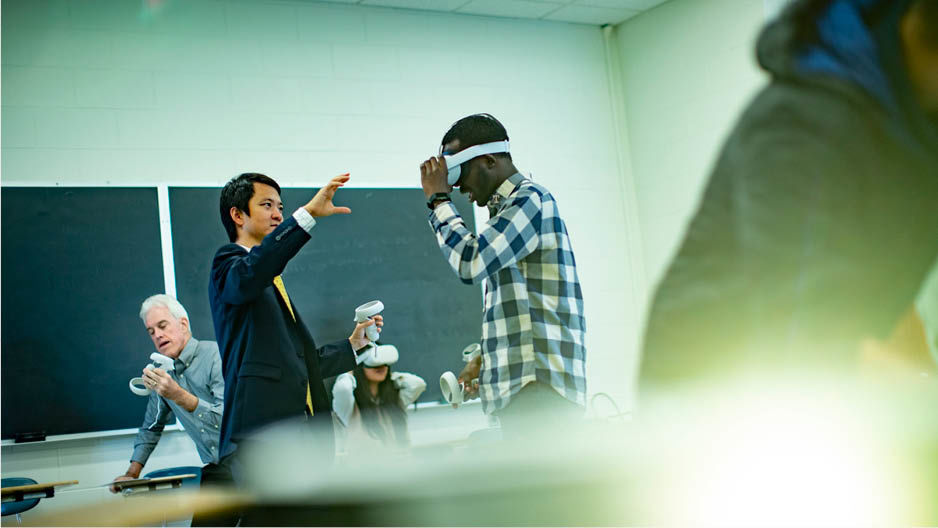The College of Education and Human Development's Di Liu, EdD, is using cutting-edge technology to help teachers develop culturally responsive pedagogy and create immersive language learning experiences.
Advanced, innovative technologies present exciting new directions for culturally responsive language instruction and online learning.
College of Education and Human Development Assistant Professor of Instruction Di Liu, EdD, is using virtual reality (VR) to help pre-service teachers expand their multicultural knowledge as well as to create their own immersive, inclusive classroom content.
Liu drew inspiration from the experiences of a group of education students who participated in a summer program at a university in China. "Students were so excited and enthusiastic about their overseas English teaching experience," Liu said. "Afterwards, they demonstrated increased consciousness of cultural diversity and recognized the importance of adapting their instructional approaches to accommodate students from diverse linguistic and cultural backgrounds."
Liu wanted to find a way to harness at least part of the power of that experience. He also wanted to make sure that pre-service teachers were thinking about language's complex socio-cultural contexts in meaningful, global ways.
Through support from Temple University's Innovative Teaching with Makerspace Technology Grant and the College of Education and Human Development, Liu initiated a two-stage project over two semesters tied to courses and field experience in the Teaching English to Speakers of Other Languages (TESOL) MSEd program and the English Language Teaching Certificate program.
The project used immersive VR technology to enhance teaching and learning. During the first phase, Liu explained, "we focused on cultivating teachers' multicultural knowledge and mindset." For the duration of the course, student teachers used Oculus headsets to enter the metaverse.
"We included immersive 360° videos showcasing various countries and regions," Liu shared. Through a social virtual reality platform, AltSpaceVR, student teachers explored their virtual surroundings and had discussions that extended their classroom learning.
Liu had students use an immersive video to explore the streets of Hong Kong. "For example, we talked about Hong Kong…and how people's use of multiple languages including Mandarin, Cantonese, and English was influenced by the local history, culture, and globalization." VR helped students to move beyond a conceptual understanding of the relationship between culture and language toward a concrete, contextualized appreciation.
Liu designed the second phase of the project to help student teachers develop pedagogical skills that would allow them to create equitable, inclusive classrooms through technology. Six student teachers volunteered to teach a class jointly developed by the College of Education and Human Development and the Temple University Center for American Language and Culture as part of their fieldwork requirement.
Student teachers used 360° cameras to capture real world environments and create immersive VR experiences that could demonstrate how language is used in conversational, cultural contexts.
One student teacher recorded his trip with a friend to a soccer game at Subaru Park in Chester, PA. "He recorded multiple conversations with his friend throughout the game," Liu shared. "In one, they talked about missing the online seat selection time. In another, they cheered and celebrated after a goal." This approach helped the student teacher introduce English language learners to more natural and authentic use of language in a specific cultural context. The student teacher then invited students to talk about sports in their own cultures. He hosted a lesson on a virtual platform that focused on improving language learners' "communicative competence"—the ability to use language effectively and appropriately in various social contexts.
"I found it fascinating that our student teachers designed lessons that go beyond grammatical and linguistic forms," Liu explained. "They were not merely teaching students how to achieve a high score in an English test; instead, they incorporated cultural norms and social conventions, cultivating students' ability to convey meaning effectively in various real-life situations."
Liu sees this approach as an exciting development beyond traditional approaches to teaching language. "Our goal is to equip teachers with the skills and knowledge needed not only for today but also for the future."
Of course, developing these new pedagogies requires technological training. Hyangeun Ji, a PhD student in Science, Mathematics and Educational Technology, played an instrumental role as a technology expert, training students to use the Oculus headsets and 360° camera, and providing one-on-one support and troubleshooting.
"I've always dreamed of getting my hands on an Oculus Rift and diving into a VR project using the device," Ji said. "So you can imagine how delighted I was when the chance came around!" She was excited to work with, and help others work with, the cutting-edge technology.
Ji also continues to partner with Liu on the research related to the pilot project. Ji interviewed the student teachers who participated in phase two and found that most participants had a very positive experience.
"They felt that all language teachers should be prepared with this new technology," Ji said. "They all liked that incorporating VR in their classrooms was immersive, engaging, and motivating—not just for students, but for themselves."
Liu and Ji have started to share their findings from this project at conferences including the TESOL 2023 Convention & English Language Expo. They are also seeking grant funding so that they can purchase more devices, expand training opportunities, and build a library of VR resources that can promote multicultural awareness for language learning.
"We're trying to build an application to prepare culturally responsive educators. Teachers can practice teaching in a virtual environment simulating classrooms in Japan, in Italy, in Brazil, and many other areas of the world."
Liu also sees exciting possibilities for expanding this work in interdisciplinary ways by working to create resources for teachers in STEM and other disciplines. Liu stated, "It's not just language teachers who need to be culturally responsive. I'm hoping that our work can also benefit educators in other fields such as Math, Science, History, and Art."
As he continues to explore how technology can foster culturally responsive classroom experiences, Liu hopes to continue to promote awareness of how teachers teach and students learn around the world.

